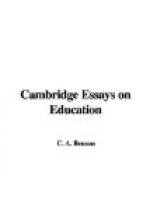Under this scheme a Register was set up, with two columns, A and B. In the former were placed the names of all teachers who had obtained the government certificate as teachers in public elementary schools. This involved no application or payment by such teachers, who were thus registered automatically. Column B was reserved for teachers in secondary schools, public and private. Registration in these cases was voluntary and demanded the payment of a registration fee of one guinea in addition to evidence of acceptable qualification in regard to academic standing and professional training. Although teachers of experience were admitted on easier terms the regulations were intended to ensure that, after a given date, everybody who was accepted for registration should have passed satisfactorily through a course of training in teaching. As designed in the first instance Column B furnished no place for teachers of special subjects and it became necessary to institute supplemental Registers in regard to music and other branches which had come to form part of the ordinary curriculum of a secondary school.
The scheme thus provided a Register divided into groups according to the nature of the accepted applicant’s work. Such an arrangement presented many difficulties since it ignored all university teachers and assigned the others to different categories depending in some instances on the type of school in which they chanced to be working and in others on the subject which they happened to be teaching.
A professional Register constructed on these lines had the seeming advantage of supplying information as to the type of work for which the individual teacher was best fitted. On the other hand it was held that the division of teachers into categories was unsound in principle and the teachers in public elementary schools were not slow to resent the suggestion that they belonged to an inferior rank and were properly to be excused the payment of a fee. They pointed out that many of their number held academic qualifications which were higher than those required to secure admission to Column B wherein some eleven thousand teachers had been registered, of whom not more than one half were graduates. The views thus expressed were shared by many other teachers and it speedily became




